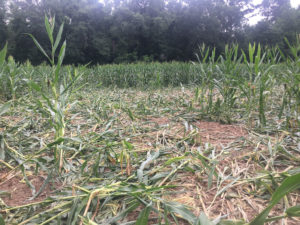UGA scientists test tools for managing invasive wild pig population

Writer: Vicky L. Sutton-Jackson, 803-725-2752, vsuttonj@srel.uga.edu
Contact: David Keiter, dak10933@uga.edu; James Beasley, (803)725-5113, beasley@srel.uga.edu
Aiken, S.C. – Wild pigs, also known as feral hogs and feral swine, are an invasive species. The descendants of domestic swine mixed with Eurasian boar were brought to the U.S. from Europe in the 1500s and since have expanded across the nation, proving to be costly.
Numbering between 5 and 6 million, wild pigs cost the U.S. more than $1.5 billion in damages annually, including agricultural damage from uprooted soils and crops, according to the National Wildlife Research Center. They can spread major diseases like E.coli, brucellosis and hepatitis E to livestock and humans. And they steal food and habitat from native species.
Efforts to manage the growth of the wild pig population have fallen short, but researchers from the University of Georgia are testing new data-gathering tools that will help guide future control measures.
“Information on birth rates, litter sizes and survival of young are essential components to understanding population growth,” said James Beasley, assistant professor at the Savannah River Ecology Laboratory and the Warnell School of Forestry and Natural Resources. “These parameters are important to determine whether the population is increasing or decreasing, as well as improve the success of management programs.”
Beasley and David Keiter, a recent UGA alumnus now at U.S. Geological Survey’s Western Ecological Center, along with researchers at the U.S. Forest Service, are the first to use a vaginal implant transmitter to identify the date, time and birth location of newborn pigs.
The team captured and inserted the VITs in female pigs located on the U.S. Department of Energy’s 310-square-mile Savannah River Site near Aiken, South Carolina.
When a pig gives birth, the VIT is expelled. A temperature-monitoring device inside the VIT alerts researchers, allowing them to travel to the birth site and equip the piglets with tracking devices.
In addition to testing the VIT, the team evaluated five different tracking devices with the goal of identifying a tamper-resistant, cost-effective transmitter that would be harmless to the newborns and function as an effective monitoring device, alerting the team when a piglet died.
Two of the five transmitters tested were found to be effective—a tag attached to the piglet’s ear, and a surgically implanted transmitter.
The VITs and the transmitters provide improved methods for determining the number of wild pigs born that survive to sexual maturity, reaching the age when they’re able to reproduce. More accurate data will help guide future population management of wild pigs.
Without such tools, researchers must comb through the woods to locate piglets, Beasley said.
“This approach misses numbers, and you lack the necessary specifics of what impacts survival,” he said.
Another approach—relying on data from hunters—is similarly flawed, according to Keiter.
“Data from hunters is often biased because hunters will generally choose to shoot larger animals or trophy animals, rather than a representative sample of the population,” he said. “And capture-mark-recapture data can also be biased because an animal is assumed dead if it has been missing for a long time.”
The study appears in the Journal of Wildlife Research and is available online at http://www.publish.csiro.au/WR/WR16204.
Co-authors on this study are John Kilgo and Mark A. Vukovich, USDA Forest Service, Southern Research Station; and Fred L. Cunningham, USDA Animal and Plant Health Inspection Service, Wildlife Services, National Wildlife Research Center, Mississippi Field Station.
###
